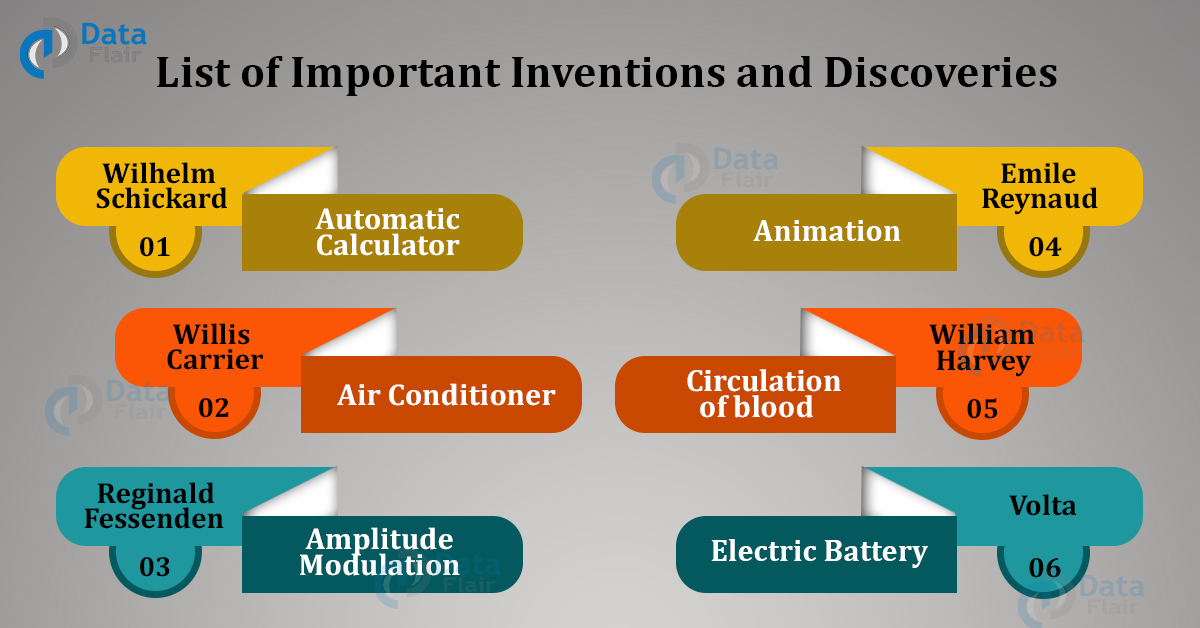List of Important Inventions and Discoveries for Competitive Exams
Are you ready for UPSC Exam? Check your preparation with Free UPSC Mock Test
Science and Technology along with inventions and discoveries have changed the world drastically. They have enabled us for centuries to evolve into a different civilization. Starting from the discovery of fire and the invention of the wheel, the world has seen wonders in the space of inventions and discoveries.
Different theories – like that of the Black Hole and other cases have been speculated on the basis of the hypothesis. The formation of the Cloud concept has enabled data to manipulate in a different manner.
Important Inventions and Discoveries
Wright Brothers were responsible for inventing the Aeroplane. The airplane in today’s world has seen different and modified prototypes. In previous years, ships were used to travel across the sea. This took a long period of time.
Now within a couple of days (along with layovers), we can find ourselves on a different continent in a short time. The Wright brothers were American Aviation pioneers who were also responsible for the invention of aircraft controls that made the fixed-wing powered flight possible.
Emile Reynaud was responsible for the invention of the praxinoscope and the first projected animation. Pantomimes Lumineuses (composed by him) was premiered on 28 October 1892 in Paris, France.
In 1888, he patented the Theatre Optique Film System. His inventions also include the use of the first instance of film perforations.
Johannes Gutenberg was a German Goldsmith and inventor of the printing press. He introduced the printing press in Europe. His Introduction of mechanical movable type printing in Europe started the Printing Revolution. It is regarded as a milestone.
It has played an important role in the Reformation, Renaissance and other ages as well. This in turn brought a change in socio-economy development.
Technology is evolving rapidly!
Stay updated with DataFlair on WhatsApp!!
Alfred B. Nobel as a scientist, engineer, and philanthropist. Even though he held 355 patents, the invention of his dynamite sets him apart the most.He owned Bofors which he redirected from its previous roles as primarily an iron and steel producer to a major manufacturer of cannon and other armaments.
He bequeathed his fortune to institute the famous Nobel Prize in Stockholm, Sweden. The synthetic element nobelium named after Alfred Nobel.
Benjamin Franklin was one of the founding fathers of the United States of America. He was a polymath. He was a leading political philosopher, scientist, postmaster, writer, politician, civic activist, statesman, humorist, and held many other significant posts.
As an inventor, he is well known for the lightning rod, bifocals, and the Franklin stove. He also founded the Library Company and the University of Pennsylvania.
William Ramsay was a Scottish Chemist who won the Nobel Prize in Chemistry in 1904 for the discovery of the noble gases. His work thereby helped in the development of a different section – Noble Gases in the periodic table. Ramsay was also the President of the British Association from 1911-1912.
He also became the advisor in the Indian Institute of Science and said that Bangalore should be the place where this institution should be established.
Lewis Waterman was the founder of the Waterman Pen Company. Before receiving many patents for his fountain pen invention, he worked as a salesman in New York. He quit after six weeks and started his own business.
He dedicated his time to the invention and developing the pen with a simplified feed of his own design. His “three fissure feed” was the first patent, granted in 1884.
Thomas Edison was an American inventor and businessman. He is considered the United States’ greatest inventor of all time.
He helped develop the electric power generation, gramophone, sound recording, and motion pictures. Lot of engineers and scientists worked with him for the aim of discovering.
Richard Gaffing was an American inventor who is best known for its invention of the Gatling gun. This is the first successful machine gun. He also invented the screw propeller and a wheat drill in 1893. He also invented the hemp brake machine, steam tractor, marine steam ram, and a tractor as well.
When he saw that majority of the soldiers lost in the Civil War due to diseases, he went on to invent this machine gun.
Alexander Graham Bell was an inventor, scientist, and engineer who is patented with founding the first practical telephone. He also co-founded American Telephone and Telegraph Company (AT&T) in 1885.
Also he went on to contribute significantly in fields of optical telecommunications, hydrofoils, and aeronautics. He also served as the 2nd President of the National Geographic Society.
Dr. Felix Hoffman was a German Chemist. He is known for re-synthesizing diamorphine. He was also known for synthesizing aspirin even though he did not do it under his own name. Hoffman considered himself to be the first person to invent aspirin. He worked as Bayer, the company.
Willis Carrier was an American Engineer. He was best known for inventing the air-conditioner. He first invented the electrical air conditioning unit in 1902. Then he also founded Carrier Corporation, a company manufacturing and dealing in the distribution of air-conditioners.
Elisha G. Otis was an American industrialist. He was the founder of Otis Elevator. He was the inventor of the elevator in the year 1852. Also, he invented a safety device.
List of Important Inventions and Discoveries
| Inventions and Discoveries | Name of the Inventor | Year of Invention |
| Automatic Calculator | Wilhelm Schickard | 1623 |
| Air Conditioner | Willis Carrier | 1914 |
| Amplitude Modulation | Reginald Fessenden | – |
| Anemometer | Leon Battista Alberti | 1450 |
| Animation | Emile Reynaud | 1892 |
| Atom Bomb | Julius Robert Oppenheimer | 1945 |
| Aspirin | Dr. Felix Hoffman | 1899 |
| Airplane | Wilbur and Orville Wright | 1903 |
| Adhesive tape | Richard G. Drew | 1923 |
| Bifocal Lens | Benjamin Franklin | 1784 |
| Barometer | Evangelista Torricelli | – |
| Barbed Wire | Joseph F. Glidden | 1873 |
| Blood Group | Karl Landsteiner | 1900 |
| Ball Point Pen | John Loud | 1888 |
| Bicycle Tyres | John Boyd Dunlop | 1888 |
| Bicycle | Kirkpatrick Macmillan | 1839 |
| Celluloid | Alexander Parkes | 1861 |
| Chloroform | E. Soberran | 1831 |
| Cine Camera | Wm. Friese-Greene | 1889 |
| Circulation of blood | William Harvey | 1628 |
| Clock Mechanical | Hsing and Ling-Tsan | 1725 |
| Diesel Engine | Rudolf Diesel | 1892 |
| Centigrade Scale | Anders Celsius | 1742 |
| Chlorine | Karl Wilhelm Scheele | 1774 |
| Dynamite | Alfred B. Nobel | 1867 |
| Diesel Engine | Rudolf Diesel | 1895 |
| Electric stove/cooker | William S. Hadaway | 1896 |
| Electroscope | Jean Nollet | 1748 |
| Electric Fan | Wheeler | 1882 |
| Electric Battery | Volta | 1800 |
| Elevator | Elisha G. Otis | 1852 |
| Electric Motor (DC) | Zenobe Gramme | 1873 |
| Electromagnet | William Sturgeon | 1824 |
| Fountain Pen | Lewis Edson Waterman | 1884 |
| Fluorine | Ferdinand Frederick Henri Moissan | 1886 |
| Gramophone | Thomas Edison | 1878 |
| Hydrogen | Henry Cavendish | 1766 |
| Helicopter | Igor Sikorsky | 1939 |
| Hovercraft | Christopher Cockerell | 1959 |
| Hot Air Balloon | Josef & Etienne Montgolfier | 1783 |
| Helium | William Ramsay | 1868 |
| Insulin | Sir Frederick Banting | 1923 |
| Jet Engine | Hans Von Ohain | 1936 |
| Lightning Conductor | Benjamin Franklin | 1752 |
| Locomotive | Richard Trevithick | 1804 |
| Laser | Dr. Charles H. Townes | 1960 |
| Light Bulb | Heinrich Goebel | 1854 |
| Motorcycle | Edward Butler | 1848 |
| Microscope | Zacharis Janssen | 1590 |
| Microphone | Alexander Graham Bell | 1876 |
| Machine Gun | Richard Gatling | 1861 |
| Neon Lamp | Georges Claude | 1915 |
| Oxygen | Antoine Laurent Lavoisier | 1775 |
| Ozone | Christian Schonbein | 1839 |
| Piano | Bartolomeo Cristofori | 1700 |
| Printing Press | Johannes Gutenberg | 1440 |
| Parachute | Jean Pierre Blanchard | 1785 |
| Polio Vaccine | Jonas Edward Salk | – |
| Periodic Table | Dmitri Mendeleev | 1869 |
| Penicillin | Alexander Fleming | 1928 |
| Pacemaker | Dr. Paul Zoll | 1952 |
| Petrol for Motor Card | Karl Benz | 1885 |
| Refrigerator | James Harrison | 1851 |
| Radium | Marie & Pierre Curie | 1898 |
| Radar | Dr. Albert H. Taylor & Leo C. Young | 1922 |
| Rubber (vulcanized) | Charles Goodyear | 1841 |
| Rocket Engine | Robert H. Goddard | 1926 |
| Radio | Guglielmo Marconi | 1894 |
| Richter Scale | Charles Richter | 1935 |
| Ship (Turbine) | Charles Parsons | 1894 |
| Steam Ship | J.C Perier | 1775 |
| Steam Boat | John Fitch | 1786 |
| Safety Match | J.E. Lundstrom | 1855 |
| Submarine | David Bushnell | 1776 |
| Stethoscope | Rene Laennec | 1816 |
| Saxophone | Adolphe Sax | 1846 |
| Sewing Machine | Elias Howe | 1846 |
| Steam-Powered Airship | Henri Giffard | 1852 |
| Soft Contact lenses | Otto Wichterle | 1961 |
| Synthesizer | Dr. Robert Arthur Moog | 1964 |
| Thermometer | Galileo | 1593 |
| Theory of Evolution | Charles Darwin | 1858 |
| Typewriter | Peter Mitterhofer | 1841 |
| Transistors | John Bardeen, William Shockley & Walter Brattain | 1948 |
| Telephone | Graham Bell | 1874 |
| Valve. Radio | Sir J.A Fleming | 1904 |
| Vacuum Cleaner | Ives McGuffey | 1869 |
| Vitamin A | Frederick Gowland Hopkins | 1912 |
| Vitamin B | Christiaan Eijkman | 1897 |
| Vitamin C | Albert Szent-Gyorgi | – |
| Vitamin K | Henrik Dam | 1929 |
| Vitamin E | Herbert McLean Evans & Katherine Scott Bishop | — |
| Windshield wipers | Mary Anderson | 1903 |
| World Wide Web | Tim Berners Lee with Robert Cailliau | 1989 |
| X-ray | Wilhelm Conrad Roentgen | 1895 |
| Xerox Machine | Chester Carlson | 1928 |
Conclusion
The world is continuously changing at a dynamic speed and inventions and discoveries are very important to be contributed to society. The inventions and discoveries have made our lives easier and quick. They are extremely important for mankind.
The world is continuously changing. In such a dynamic world, where SpaceX is all set for Mars, the dreams of discovery and inventions centuries ago might have not been able to imagine this.
Your 15 seconds will encourage us to work even harder
Please share your happy experience on Google



i want seience